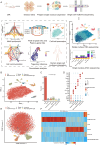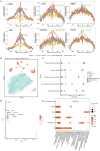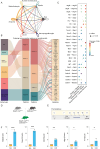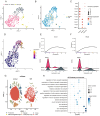Single-Cell Multiomics Profiling Reveals Heterogeneity of Müller Cells in the Oxygen-Induced Retinopathy Model
- PMID: 39504047
- PMCID: PMC11547256
- DOI: 10.1167/iovs.65.13.8
Single-Cell Multiomics Profiling Reveals Heterogeneity of Müller Cells in the Oxygen-Induced Retinopathy Model
Abstract
Purpose: Retinal neovascularization poses heightened risks of vision loss and blindness. Despite its clinical significance, the molecular mechanisms underlying the pathogenesis of retinal neovascularization remain elusive. This study utilized single-cell multiomics profiling in an oxygen-induced retinopathy (OIR) model to comprehensively investigate the intricate molecular landscape of retinal neovascularization.
Methods: Mice were exposed to hyperoxia to induce the OIR model, and retinas were isolated for nucleus isolation. The cellular landscape of the single-nucleus suspensions was extensively characterized through single-cell multiomics sequencing. Single-cell data were integrated with genome-wide association study (GWAS) data to identify correlations between ocular cell types and diabetic retinopathy. Cell communication analysis among cells was conducted to unravel crucial ligand-receptor signals. Trajectory analysis and dynamic characterization of Müller cells were performed, followed by integration with human retinal data for pathway analysis.
Results: The multiomics dataset revealed six major ocular cell classes, with Müller cells/astrocytes showing significant associations with proliferative diabetic retinopathy (PDR). Cell communication analysis highlighted pathways that are associated with vascular proliferation and neurodevelopment, such as Vegfa-Vegfr2, Igf1-Igf1r, Nrxn3-Nlgn1, and Efna5-Epha4. Trajectory analysis identified a subset of Müller cells expressing genes linked to photoreceptor degeneration. Multiomics data integration further unveiled positively regulated genes in OIR Müller cells/astrocytes associated with axon development and neurotransmitter transmission.
Conclusions: This study significantly advances our understanding of the intricate cellular and molecular mechanisms underlying retinal neovascularization, emphasizing the pivotal role of Müller cells. The identified pathways provide valuable insights into potential therapeutic targets for PDR, offering promising directions for further research and clinical interventions.
Conflict of interest statement
Disclosure:
Figures




Similar articles
-
Pulmonary surfactant protein a is expressed in mouse retina by Müller cells and impacts neovascularization in oxygen-induced retinopathy.Invest Ophthalmol Vis Sci. 2014 Nov 18;56(1):232-42. doi: 10.1167/iovs.13-13652. Invest Ophthalmol Vis Sci. 2014. PMID: 25406276 Free PMC article.
-
Single-cell analysis identifies MKI67+ microglia as drivers of neovascularization in proliferative diabetic retinopathy.J Transl Med. 2025 Mar 11;23(1):310. doi: 10.1186/s12967-025-06320-w. J Transl Med. 2025. PMID: 40069725 Free PMC article.
-
Inhibition of Vascular Endothelial Growth Factor Reduces Photoreceptor Death in Retinal Neovascular Disease via Neurotrophic Modulation in Müller Glia.Mol Neurobiol. 2025 May;62(5):6352-6368. doi: 10.1007/s12035-025-04689-9. Epub 2025 Jan 9. Mol Neurobiol. 2025. PMID: 39789237
-
Retinal vascular development and oxygen-induced retinopathy: a role for adenosine.Prog Retin Eye Res. 2003 Jan;22(1):95-111. doi: 10.1016/s1350-9462(02)00058-7. Prog Retin Eye Res. 2003. PMID: 12597925 Review.
-
Müller cells trophism and pathology as the next therapeutic targets for retinal diseases.Prog Retin Eye Res. 2025 May;106:101357. doi: 10.1016/j.preteyeres.2025.101357. Epub 2025 Apr 18. Prog Retin Eye Res. 2025. PMID: 40254246 Review.
Cited by
-
Müller cells and retinal angiogenesis: critical regulators in health and disease.Front Cell Neurosci. 2024 Dec 10;18:1513686. doi: 10.3389/fncel.2024.1513686. eCollection 2024. Front Cell Neurosci. 2024. PMID: 39720707 Free PMC article. Review.
-
AI-Driven Analysis Unveils Functional Dynamics of Müller Cells in Retinal Autoimmune Inflammation.bioRxiv [Preprint]. 2025 May 12:2025.02.28.640907. doi: 10.1101/2025.02.28.640907. bioRxiv. 2025. PMID: 40093069 Free PMC article. Preprint.
References
MeSH terms
Substances
LinkOut - more resources
Full Text Sources
Molecular Biology Databases
Miscellaneous

